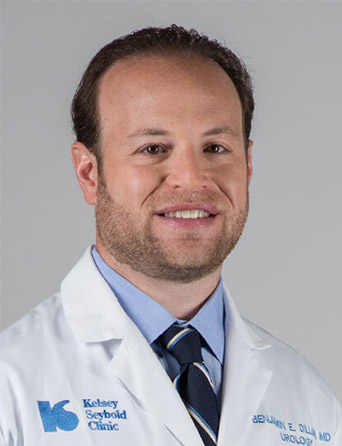Join Our eNewsletter!
Subscribe to our monthly newsletter to receive encouraging advice to help you lead a healthy lifestyle.

Personalized Treatment Options Available for Pelvic Prolapse
Pelvic organ prolapse (POP) is a common women’s health condition in which certain internal organs move or drop as a result of weakened muscles, ligaments, and connective tissue in the pelvis.
“An estimated 24% of women in the U.S. will have some degree of POP, with roughly 11% needing surgery for prolapse over their lifetime,” says Benjamin Dillon, MD, Associate Chief of Urology at Kelsey-Seybold Clinic, who specializes in the treatment of pelvic organ prolapse and male and female incontinence. He adds that the full extent of POP cases isn’t known because many women don’t disclose their symptoms due to embarrassment.
The Many Causes of POP
“Increasing age, pregnancy, obesity, prior pelvic surgery, and genetics all may be contributing factors to the development of POP,” Dr. Dillon says.
He points to the following as common causes:
- Vaginal childbirth, particularly large birth weight babies, multiple childbirths, or difficult delivery
- Menopause-related pelvic floor muscle deterioration after a drop in hormone levels
- Family history of POP/genetics
- Chronic constipation
- Chronic coughing
Five Common Symptoms
Dr. Dillon says symptoms of POP are typically:
- Pressure, pain, or “fullness” in the vagina or rectum or both
- Sensation of “your insides falling out”
- Urinary incontinence
- Chronic constipation
- Back/abdominal pain
Surgical and Nonsurgical Treatment Options
“Treatment of POP is an individual and personal matter. Not every woman with prolapse needs to have intervention. However, for those women who do wish to address their prolapse, surgery may be the preferred treatment option,” explains Dr. Dillon. “Your doctor will perform a physical exam to help determine the best way to approach a repair of the prolapse.”
There are several ways to repair prolapse, including a vaginal approach without the use of surgical mesh, an abdominal approach, or a minimally invasive approach. Surgical options include:
- Abdominal repair to help restore natural anatomic position
- Transvaginal (through the vagina) repairs
- Robotic surgery and laparoscopic repairs
If your doctor recommends surgery, you may be a candidate for a robotic (da Vinci®) “sacrocolpopexy.” Using state-of-the-art technology, robotic surgery requires only a few tiny incisions, which generally allows for a shorter recovery.
The da Vinci® system enables your doctor to operate with enhanced vision, precision, dexterity, and control, and with less blood loss.
Nonsurgical treatment options include Kegel exercises, core strengthening exercises, hormone replacement therapy, and support garments.
When to Seek Help
“It may not happen quickly, but if left untreated, pelvic organ prolapse almost always gets worse,” says Dr. Dillon. The good news is that prolapse generally isn’t life threatening.
Treatment of prolapse should be based on symptoms. In rare cases, severe prolapse may lead to an inability to empty the bladder, which may progress to kidney damage or infection.
When this occurs, prolapse treatment is considered urgent. In most other cases, however, patients should be the ones to decide when to have their prolapse treated based on their symptoms, level of discomfort, and quality of life.
“Consult with your doctor about treatment options you might want to consider,” advises Dr. Dillon, who is fellowship trained in female pelvic medicine and reconstructive surgery.


